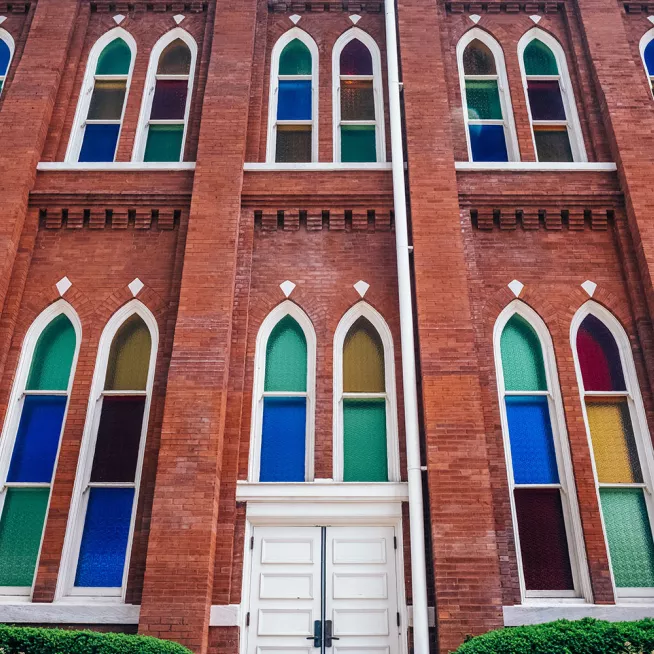Breadcrumb
Multidisciplinary Artist LaJuné McMillian Explores Black Freedom and Movement Through New Digital Media and Performance
LaJuné McMillian: The Portal’s Keeper—Origins September 27, 2024 – January 5, 2025.
NASHVILLE, Tenn. —The Frist Art Museum presents LaJuné McMillian: The Portal’s Keeper—Origins, an exhibition of multimedia projections, sculptural installations, and holographic self-portraits by the New York–based artist LaJuné McMillian. Organized by the Frist Art Museum, the exhibition will be on view in the Gordon Contemporary Artists Gallery from September 27, 2024 through January 5, 2025.
LaJuné McMillian uses 3D-modeling technology, motion-captured performances, and multisensory elements to create immersive, dynamic environments where they explore and celebrate Black bodily movement as an expression of liberation. With their use of motion-capture software, McMillian depicts Black dancers, performers, and the artist themself as avatars whose intense colors and exuberant bodies move within fantastic environments in response to poems, incantations, and an array of musical and extra-musical sounds.
“Throughout the works in this exhibition, the body—sinuous and vital, uninhibited and unencumbered—moves from a place of pain into one of new possibility,” writes Frist Art Museum chief curator Mark Scala. “In suggesting that technology can help Black people imagine a more empowered future for themselves, McMillian’s marvelous works explode the legacy of centuries in which the Black body was bound, constrained, abused, and exploited.”
Kinetic movement as a focus in McMillian’s practice can be traced to a lifelong interest in figure skating. In their role as the director of Figure Skating in Harlem, McMillian combined skating lessons with a STEAM curriculum for young Black girls. In 2018, they started the Black Movement Library, an online database of motion capture and video recordings of Black performers, to preserve and celebrate bodily motion as an important yet ephemeral aspect of Black culture. McMillian describes it as “an archive of Black existence” and a way of “connecting us with our ancestors and the future.”
The centerpiece of the exhibition is Spirit and Child, an extended-reality installation with three-channel projections of avatars generated from motion-captured performances, who dance amid psychedelic abstract shapes and forms that warp in mesmerizing motions. A physical arch in the center of the installation forms the exhibition’s titular portal; inside is an abstract figure who appears to be running through the mystical space. An orchestration of sounds and spoken word further enhance the experience. “Spirit and Child is a prayer of pain and recovery that explores the limits of the body and the expansiveness of the soul,” writes Scala. “The avatars’ voices are the artist’s own—a confused and distraught child who cannot grasp and may not be able to justify living in the body and world they were born into, and the grown self who has survived to offer perspective, comfort, and wisdom.”
McMillian further explores the theme of self in differing roles within Mother and Child, an evocative sculptural self-portrait. A black cast of the artist’s face is surrounded by yaki, artificial yak hair, a material that holds deep meaning to the artist. They connect it to Tibetan Buddhism, in which a yak’s body parts are believed to have been transformed into the sun, moon, stars, rivers, lakes, forests, and mountains. “Yaki is also used in hair extensions and wigs worn by many Black women, so it has an additional layer of cultural significance,” writes Scala.
Projected onto the sculpture’s hair is a film of the artist’s mother styling their hair as a child, which, in contrast to the yaki symbolism, carries a more severe connotation for McMillian. “Growing up, I associated my relationship with my hair to pain and sacrifice. Sitting long hours in uncomfortable positions, I was told and reminded that beauty was pain, and that my ability to sit in stillness even when suffering would be rewarded” the artist explains. “I often wonder how we teach young Black children about pain. How we associate pain with obedience.”
The final section of the exhibition highlights multiple holographic self-portraits. The three-dimensional morphing patterns and motion-captured figures loop perpetually in a cycle of formation and reformation, suggesting the mobility and adaptability of one’s identity through liberated movement. “This self-portrait series shows how figures can be depicted in ways that stress their humanity even within the nonphysical spaces of technology,” writes Scala.
As an interactive component in the gallery, Prayer Consciousness offers guests a series of prompts on a computer and the opportunity to write and share their own prayers.
###







